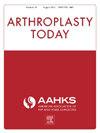Failure of the Noncontact Bridging Periprosthetic Plating System: A Single-Institution Experience
IF 2.1
Q3 ORTHOPEDICS
引用次数: 0
Abstract
Background
Periprosthetic femur fractures (PFFs) are challenging complications following total joint arthroplasty. Locking compression plates have emerged as a preferred option because of their stability and ability to be placed in a minimally invasive fashion. Surgical techniques for their application have been well-described; however, there are limited reports of failure. Here, we present 6 unique cases of implant failure using the Noncontact Bridging (NCB) Periprosthetic Plating System in the management of PFF.
Methods
A retrospective chart review was conducted of all open reduction internal fixation procedures using the NCB plating system for PFF performed at a single tertiary academic trauma center from 2015 to 2022. Instances of postoperative implant failure were selected for review. Surgical information regarding their index PPF and subsequent open reduction internal fixations were collected.
Results
Of the 44 instances the NCB plating system was used, 6 (13.6%) cases of implant failure were identified. Four out of 6 cases occurred within 4 months of fixation. Five of the failures were due to plate fracture and 1 by plastic deformation. Failure of the plate was noted at the tip of the prosthesis in 5 out of 6 cases. Stress concentration was minimized by avoiding the use of 3 consecutive screw plate holes in all cases.
Conclusions
Here we present the largest case series to date of NCB plating system failure. These cases highlight the need for further surveillance of plate failure in the management of PFF, as well as ways in which system design could be improved.
Level of Evidence
IV.
非接触桥接假体周围镀系统的失败:单一机构的经验
背景:假体周围股骨骨折(pff)是全关节置换术后具有挑战性的并发症。锁定加压钢板因其稳定性和以微创方式放置的能力而成为首选。其应用的外科技术已经得到了很好的描述;然而,有有限的失败报告。在此,我们报告了6例使用非接触桥接(NCB)假体周围电镀系统治疗PFF的假体失败病例。方法回顾性分析2015 - 2022年在某三级学术创伤中心使用NCB钢板系统治疗PFF的所有切开复位内固定手术。选择术后种植失败的病例进行回顾。收集他们的指数PPF和随后的切开复位内固定手术信息。结果在44例使用NCB系统的患者中,发现6例(13.6%)种植体失败。6例中有4例发生在固定后4个月内。其中板断裂破坏5次,塑性变形破坏1次。6例中有5例假体尖端钢板失效。所有病例均避免使用3个连续螺钉板孔,从而使应力集中最小化。在这里,我们提出了迄今为止最大的NCB电镀系统故障病例系列。这些案例突出了在PFF管理中进一步监测钢板失效的必要性,以及改进系统设计的方法。证据水平
本文章由计算机程序翻译,如有差异,请以英文原文为准。
求助全文
约1分钟内获得全文
求助全文
来源期刊

Arthroplasty Today
Medicine-Surgery
CiteScore
2.90
自引率
0.00%
发文量
258
审稿时长
40 weeks
期刊介绍:
Arthroplasty Today is a companion journal to the Journal of Arthroplasty. The journal Arthroplasty Today brings together the clinical and scientific foundations for joint replacement of the hip and knee in an open-access, online format. Arthroplasty Today solicits manuscripts of the highest quality from all areas of scientific endeavor that relate to joint replacement or the treatment of its complications, including those dealing with patient outcomes, economic and policy issues, prosthetic design, biomechanics, biomaterials, and biologic response to arthroplasty. The journal focuses on case reports. It is the purpose of Arthroplasty Today to present material to practicing orthopaedic surgeons that will keep them abreast of developments in the field, prove useful in the care of patients, and aid in understanding the scientific foundation of this subspecialty area of joint replacement. The international members of the Editorial Board provide a worldwide perspective for the journal''s area of interest. Their participation ensures that each issue of Arthroplasty Today provides the reader with timely, peer-reviewed articles of the highest quality.
 求助内容:
求助内容: 应助结果提醒方式:
应助结果提醒方式:


